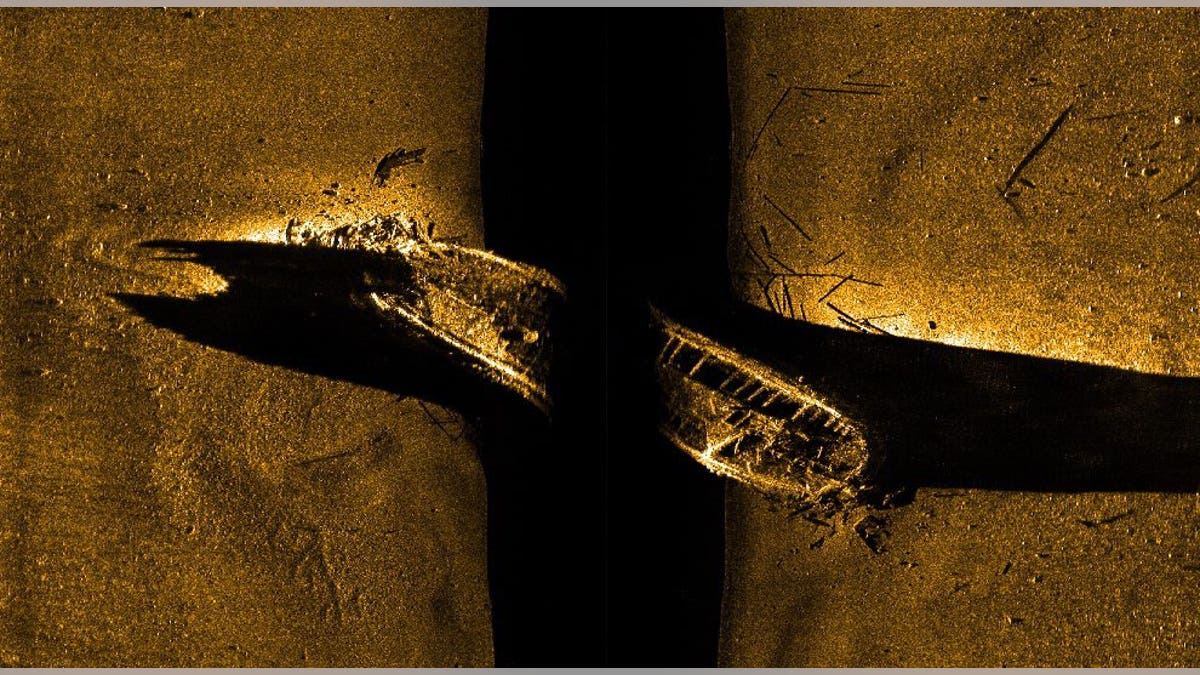
FILE - In this file image released by Parks Canada, shows a side-scan sonar image of a ship on the sea floor in northern Canada. Sir John Franklin was likely sailing on the HMS Erebus vessel when it vanished along with another vessel 170 years ago, Canada's prime minister announced Wednesday, Oct. 1, 2014. (AP Photo/Parks Canada, via The Canadian Press, File) (The Associated Press)
TORONTO – Experts identified a shipwreck uncovered last month in the Arctic as the HMS Erebus, the ship British Rear Adm. Sir John Franklin was likely sailing on when it vanished along with another vessel 170 years ago, Canada's prime minister announced Wednesday.
Experts believed the shipwreck was either the HMS Erebus and the HMS Terror, both of which sailed under the command of Franklin on an unsuccessful search for the Northwest Passage
Stephen Harper said in Parliament that experts have identified the wreck as the HMS Erebus, which Franklin was believed to have been aboard and perhaps died on.
Harper's office said confirmation was made by underwater archeologists, following a meticulous review of data and artifacts observed from the Arctic Ocean's seabed and using high-resolution photography, high-definition video and multi-beam sonar measurements.
Canada announced in 2008 that it would look for the ships, and Harper's government has poured millions into the venture, with the prime minister himself taking part in the search. It's all part of Harper's plan to boast Canadian nationalism and a sense of ownership of the north. Harper's government made the project a top priority as it looked to assert Canada's sovereignty over the Northwest Passage, where melting Arctic ice in recent years has unlocked the very shipping route Franklin was after.
Canada says it owns the passage. The U.S. and others say it is international territory.
The well-preserved wreck of one of the vessels was found last month 12 yards below the surface, near King William Island, about 2,000 kilometers northwest of Toronto.
"It is in astonishing condition," said John Geiger, president of the Royal Canadian Geographical Society. Geiger was with the search team. "We're over the moon. Not only did we find one of Franklin's ships, we found Erebus, the ship Franklin himself was on, and we found it in such incredible condition."
Geiger said the resemblance and size of Franklin's cabin, among other factors, led to their conclusion.
"It is largely intact," he said. "There is absolutely no question it is Erebus. It's not like it's a hollowed hull that's been worked over. It's basically like a time capsule of a very different time than our own. It's got things that will be very helpful as we continue to try to understand the Franklin disaster."
Last seen in the 1840s, the two ships have long been among the most sought-after prizes in marine archaeology and the subject of songs, poems and novels.
Franklin and 128 hand-picked officers and men disappeared after setting out in 1845 for the Northwest Passage, the long-sought shortcut to Asia that ran from the Atlantic to the Pacific by way of the harsh, ice-choked Arctic.
Historians believe the ships were lost in 1848 after they became locked in the ice near King William Island and the crews abandoned them in a hopeless bid to reach safety. Inuit lore tells of "white men who were starving" as late as the winter of 1850 on the Royal Geographical Society Island.
For many years afterward, Franklin was celebrated as a Victorian-era hero.
Dozens of searches by the British and Americans in the 1800s failed to locate the wrecks, and some of those expeditions ended in tragedy, too. But they opened up parts of the Canadian Arctic to discovery and ultimately spied a Northwest Passage, though it proved inhospitable to shipping because of ice and treacherous weather.
The search for an Arctic passage to Asia frustrated explorers for centuries, beginning with John Cabot's voyage in 1497. The shortcut eluded other famous explorers, including Henry Hudson and Francis Drake.
No sea crossing was successful until Roald Amundsen of Norway completed his trip in 1903-06.
There is no current plan to raise Erebus, but Geiger said it would be possible and Canadians might eventually want that done. The exact location of the wreck was not disclosed for fear of looters.
HMS Terror has not been found.
